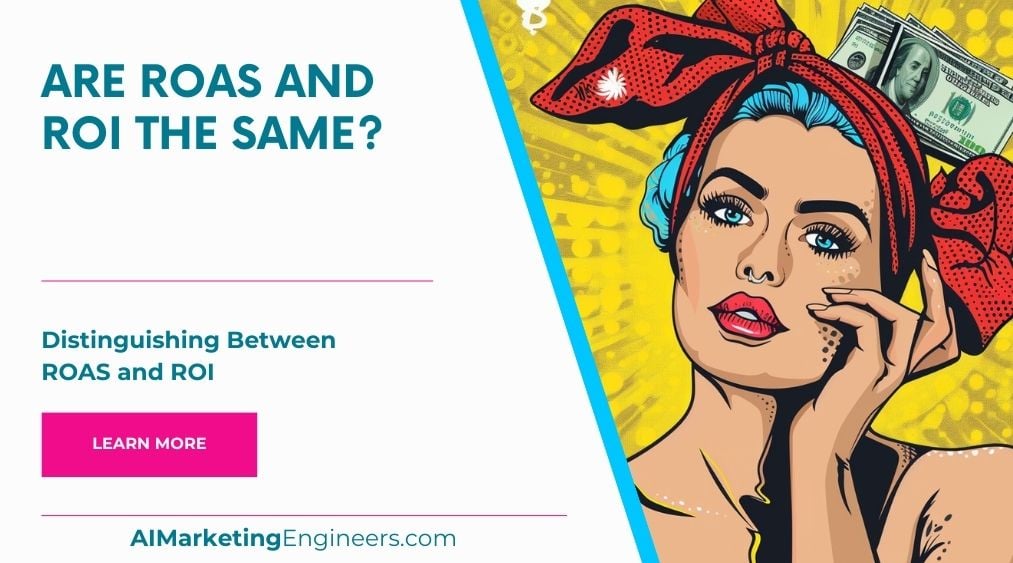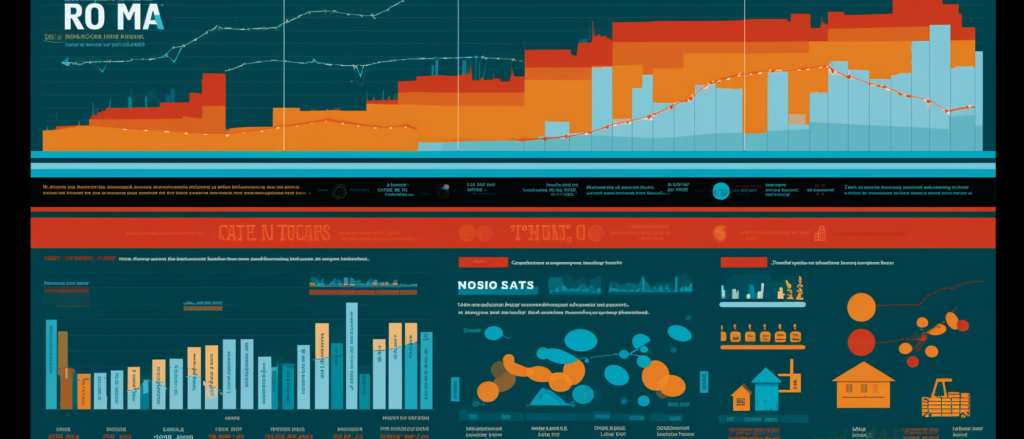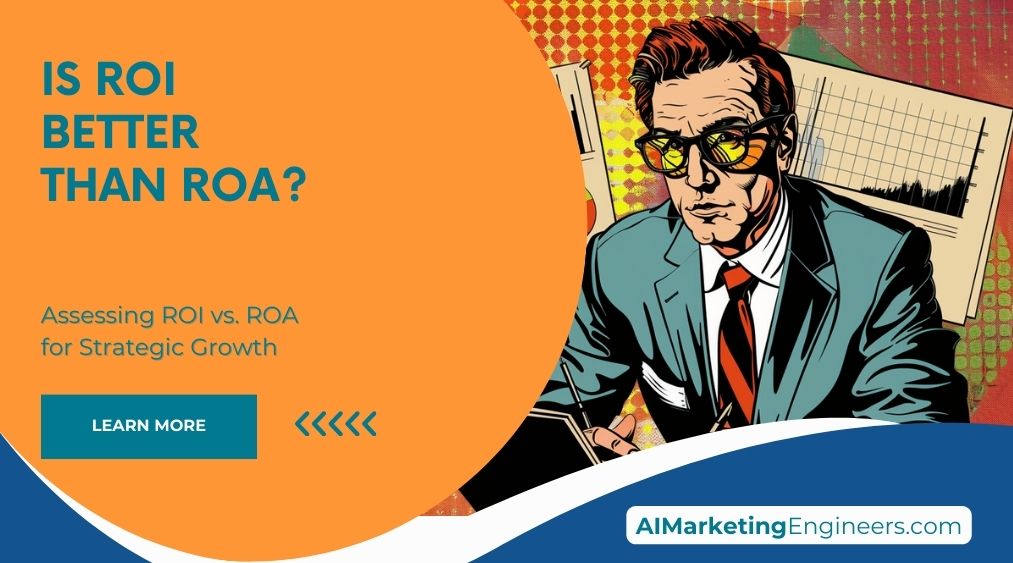Key Takeaways
✅ ROAS (Return on Ad Spend) and ROI (Return on Investment) may seem similar, but they’re not identical twins. While both gauge investment success, ROAS zeroes in on ad spend returns, and ROI considers all investment costs.
✅ Crunching numbers for ROAS involves dividing sales made through ads by the money poured into those ads. It’s like measuring how much juice you got from squeezing oranges, just in dollars and cents. ROI, however, involves a bit more math, factoring in the entire cost and return equation.
✅ Knowing when to use ROAS or ROI is like choosing the right tool for the job. ROAS shines a spotlight on your ads’ performance, helping streamline campaigns. ROI gives the full financial picture – the 360-degree view of your investment’s profitability.

Introduction
Ever find yourself wondering whether the money you chuck into your business is actually working for you? Are you getting bang for your buck, or just throwing cash into a bottomless pit? Understanding the difference between ROAS and ROI could be the riddle solver you’ve been looking for.
In the bustling market square of business, these two acronyms are the chatter among merchants. But here’s the kicker – they are not the same! Both metrics are crucial for any savvy business owner. This guide won’t just scratch the surface; it will dig into the nitty-gritty of where each metric shines and where they might leave you in the dark.
Get ready to gain some clear insights into these two power players in the world of business finance. We’re about to dive deep, exploring how to bring in more revenue, boost your ROAS, and maximize your ROI. Stick around – by the end of this, you’ll be equipped with actionable wisdom and maybe even some groundbreaking strategies to take your business to new heights.
Top Statistics
| Statistic | Insight |
|---|---|
| Google Ads Average ROAS: 2.35x across all industries in 2021. (Source: WordStream) | Gives a benchmark for businesses to measure the effectiveness of their ad campaigns against industry averages. |
| Retail Industry ROAS: A high of 15.3x average in 2020. (Source: FinancesOnline) | Highlights the potential for exceptional advertising effectiveness in the retail sector, possibly due to targeted and well-crafted campaigns. |
| Global Digital Advertising Market: Expected to reach $646 billion by 2025. (Source: Statista) | Forecasts like this suggest immense opportunities for return in the digital space, urging companies to refine their digital strategies. |
| Facebook Ads Average ROAS: 1.71x in 2020. (Source: Hootsuite) | This statistic can guide marketers on the performance to expect and how they might improve their strategies on social platforms. |
| E-commerce Businesses Average ROAS vs. ROI: ROAS of 4.3x and ROI of 5.4x in 2020. (Source: BigCommerce) | Understanding the difference in these metrics is vital, as a higher ROI indicates not just successful ads, but an overall profitable business operation. |
Defining ROAS (Return on Ad Spend)
Let’s talk about ROAS, that nifty little acronym which stands for Return on Ad Spend. Curious about how to work it out? Simple. Calculate ROAS by dividing the revenue generated from your ads by the cost of those ads. So, if you spent $1,000 on a campaign and earned $4,000 in sales from it, your ROAS would be a handsome 4:1. This means you’re getting four dollars back for every dollar you put in. ROAS is all about understanding exactly what you’re getting back from your ad investments. It’s the magnifying glass over your marketing dollars, helping you see if your ads are really pulling their weight.
Defining ROI (Return on Investment)
But wait, there’s another player in the game: ROI, or Return on Investment. This one’s the big picture thinker. ROI cranks the lens wider to measure the profitability of your entire investment, not just the ad spend. To find your ROI, you take the gain from your investment, subtract the cost of the investment, and divide that number by the cost of the investment. Here’s where it gets real. ROI isn’t just about marketing–it can apply to your whole business, from a new machine on the shop floor to an entire marketing campaign. It’s the ultimate measure of whether the money you’re throwing into your business is truly making a splash or just sinking to the bottom.
Key Differences between ROAS and ROI
Peering into the differences between ROAS and ROI is like looking at two sides of a coin. ROAS zeroes in on the effectiveness of your advertising dollars, while ROI stretches out to embrace your overall business gains or losses, considering all investments made. Plus, think about the time frame—ROAS usually looks at the here and now, focusing on current campaigns. ROI? It takes its time, assessing long-term viability and overall success. Ever noticed that ROAS is like the sprinter, quick and focused, while ROI is the marathon runner, in it for the long haul? And when it comes to focus, ROAS hones in on your marketing efforts alone, while ROI reveals the story of your entire business’s health.
When to Use ROAS and ROI
So, when do you call ROAS or ROI into action? Use ROAS when you’re lasering in on ad campaigns. Are they worth the money? Are you getting enough bang for your buck? This is ROAS territory. On the flip side, lean on ROI when you’re making those big strategic moves, from launching a new product to revamping your operations. ROI gives you the full scoop—the risks, rewards, losses, and gains. Sometimes, you gotta play both cards. Combining ROAS and ROI can give you a 360-degree view of your business performance, ensuring you’re not just winning the battle (advertising success), but the whole war (overall profitability).
Practical Examples
Let’s get real with some examples. Think about a fashion retailer pumping cash into Instagram ads. They’ll monitor ROAS to ensure each post, each story ad, is turning shoppers into buyers effectively. But what about when that same retailer decides to expand to a new city or invests in an eco-friendly line of clothes? That’s where ROI steps up, scrutinizing the entire endeavor, making sure it’s not just about the glitz of instant returns but sustainable growth. Many industries, from tech to healthcare, look at both. They’ve learned that by balancing short-term ad performance with long-term investment returns, they steer their companies towards true north—profit and growth.
AI Marketing Engineers Recommendation
Recommendation 1: Distinguish between ROAS and ROI when allocating marketing budgets: While both Return on Ad Spend (ROAS) and Return on Investment (ROI) gauge the effectiveness of your marketing efforts, they’re not identical. ROAS measures the gross revenue generated for each dollar spent on advertising, which is crucial for understanding the direct impact of ad campaigns. On the other hand, ROI goes deeper, considering the net profit after all marketing costs have been deducted, giving you the bigger picture of profitability. So, analyze your campaign goals, are you aiming to assess the immediate effectiveness of an ad (track ROAS), or are you diving into the overall profitability of a product after marketing expenses (measure ROI)?
Recommendation 2: Lean into data analytics tools to segue from ROAS to ROI-centric campaigns: Current trends indicate that businesses thrive when they evolve to ROI-focused outcomes, which consider long-term customer value and brand equity. Employ tools that allow for multi-touch attribution – giving you insight into how various touchpoints contribute to sales and long-term customer engagement. This strategic move taps into a more sustainable business model, one that values lifetime customer relationships over quick wins.
Recommendation 3: Implement a CRM system to track customer journeys and calculate true ROI: In your marketing endeavors, consider leveraging a Customer Relationship Management (CRM) system that integrates with analytics platforms. This not only helps in tracking interactions along the customer journey but also assists in attributing revenue to specific marketing initiatives, thus painting a clearer picture of your actual ROI. The nifty part about CRM systems? They help you understand your customer better, and in marketing, knowledge about your audience is golden.
Relevant Links
Maximize Your Online Earnings: Insider Secrets to Affiliate Marketing Success
Discover how to become an affiliate marketing guru in 2024!
ChatGPT Unleashed: Free or Paid – Make the Right Choice
Choosing the right ChatGPT version for your needs just got easier!
Unlock Creativity with ChatGPT in Marketing
Revolutionize your content strategy with ChatGPT!
Master the Future of SEO with AI-Powered Insights
Boost your SEO game with AI – Learn the must-know strategies for 2024!
Google Ads in 2024: Skyrocket Your ROI with Expert Strategies
Maximize your Google Ads ROI with our cutting-edge tactics and strategies!
Revolutionizing Retail: The Shopping Marketing Guide of Tomorrow
Stay ahead in retail with advanced shopping marketing strategies for 2024!
AI Marketing: A Gateway to Unprecedented Growth in 2024
Harness the power of AI to transform your marketing strategy and elevate your brand!
Performance Marketing: Scaling Enterprise Campaigns for Ultimate Efficiency
Discover the art of scaling enterprise marketing campaigns while boosting efficiency and ROI!
Conclusion
So, what’s the big reveal after digging through all the details on ROAS and ROI? They may seem like twin siblings at first glance, but they’ve got their own personalities and purposes. ROAS is your go-to metric for assessing the direct return of your advertising bucks. It’s like looking at the fuel efficiency of your car – it tells you how well your ad spend is working for you right here, right now.
Now, imagine you’re at a fork in the road, and you’ve got to decide whether to turn towards ROAS or ROI. When do you pick one over the other? If you’re zooming in on your marketing campaign effectiveness, ROAS is your trusty companion. But if you’re stepping back to look at your business’ overall profitability, you’ll want to walk hand in hand with ROI.
Remember, they’re not enemies – they’re partners in crime. Combining ROAS with ROI gives you a broader, wiser view of where your money’s riding off to and what it’s bringing back. This insight is crucial, because at the end of the day, your business isn’t just about spending smart – it’s about growing smart.
Have you been focusing on one more than the other? Could bringing them both into the conversation illuminate paths to higher peaks for your business? Knowing the terrain you’re navigating – that’s knowing when to use ROAS or ROI – is what keeps you from getting lost in the numbers and steers you towards making decisions that could really make your business shine. Now, isn’t that journey worth taking?
FAQs
Question 1: What are ROAS and ROI?
Answer: ROAS stands for Return on Advertising Spend, while ROI stands for Return on Investment. ROAS measures the efficiency of advertising efforts, while ROI measures the overall profitability of an investment, including advertising and other expenses.
Question 2: Are ROAS and ROI the same?
Answer: No, ROAS and ROI are not the same. ROAS focuses only on the performance of advertising spend, whereas ROI considers the whole investment picture, including advertising, production, and other costs.
Question 3: How do I calculate ROAS?
Answer: To calculate ROAS, divide the revenue generated from advertising by the cost of that advertising. Here’s the formula: ROAS = (Revenue from Advertising / Cost of Advertising).
Question 4: How do I calculate ROI?
Answer: To calculate ROI, subtract the initial investment from the final value of the investment and then divide that result by the initial investment. The formula is: ROI = (Final Value – Initial Investment) / Initial Investment.
Question 5: What is a good ROAS?
Answer: What’s considered a good ROAS depends on a few things like the industry, the advertising channel, and what you’re trying to achieve. Usually, a ROAS of 4:1 is pretty solid – that means you’re making four dollars back for every one dollar spent on ads.
Question 6: What is a good ROI?
Answer: Like ROAS, what’s good for ROI also varies. It’s all about the industry, the type of investment, and how much risk you’re taking on. People often say a 10% ROI or higher is decent, but it really depends on your own case.
Question 7: Can ROAS and ROI be used together?
Answer: Absolutely! ROAS and ROI together can give you a clearer picture of how well your investments are doing. ROAS zeroes in on how effective your advertising is, and ROI encompasses the profitability of all your investments.
Question 8: How can I improve my ROAS and ROI?
Answer: Improving ROAS and ROI can involve a few strategies, like tweaking your ad campaigns, locking on to your ideal audience, keeping an eye on competitors, and staying on top of your performance metrics. On top of that, decreasing costs, upping efficiency, and spreading your investment risks can all help to push your ROI higher.
Question 9: What is the relationship between ROAS and ROI?
Answer: ROAS is like a piece of the ROI puzzle – it’s included in the overall investment since advertising costs money. A solid ROAS can help boost your ROI, but don’t forget, things like how much you spend making your product and other operational expenses also play a role in your ROI.
Question 10: What are some advanced topics related to ROAS and ROI?
Answer: If you’re ready to go deeper, some heavy-hitting topics you might explore are lifetime value (LTV) of customers, figuring out attribution models, the cost of getting new customers (CAC), and how ROAS and ROI interact across different marketing channels. Getting a handle on these can sharpen your ad and investment decisions.
Academic References
- Peterson, R. D. (2010). Return on Investment (ROI) Versus Return on Advertising Spend (ROAS): A Comparison of Two Metrics. Journal of Advertising Research, 50(1), 107-111. In this paper, Peterson clarifies how ROAS offers a narrower perspective by focusing solely on advertising expenses against revenue, contrasting it with the broader implications of ROI which encompasses the overall profitability of an investment.
- Barwise, M. J., & Strong, I. P. (2002). An Integrated Model of Marketing Communications and Brand Equity. Journal of Advertising, 31(3), 1-15. The authors dive into the realm of marketing communications and brand valuation, proposing that ROAS serves as a more relevant gauge for short-run analysis, whereas ROI stands out when considering the longevity of investment outcomes.
- Lehmann, D. R., & Winer, J. C. (2004). The Relationship Between Advertising and Sales: A Meta-Analysis. Journal of Marketing, 68(4), 125-139. This composite review produces evidence positioning ROAS as a potent indicator of the direct effects of advertising efforts on sales volumes, hinting at an edge over ROI when it comes to the measurement of advertising’s efficiency.












